

For the owner who wants plenty of room for living coupled with an exceptional lot of ability and withal the ability to sail well I warmly suggest this little number, Marie-Princess. Despite the modest overall length of only 30 feet and 4 inches; and with a breadth of beam of 9 feet this boat has accommodations of startling capacity.

Look down the companionway. There in the dusk and the charm of the boat's interior are four full size made up berths, a pair both ends of the cabin scheme: between and handy to both sleeping cabins lie the galley, separate toilet room, lockers, and dining nook. Room here for four persons, two each side a built in table with roomy lockers built in the ample space behind. The quietest places of all aboard any boat are the accommodations closest to the middle sections, and here is no exception. The floor space is wide throughout the whole length of the cabin, the headroom close to 6 feet where one must walk, and the whole interior has the air of snugness and comfort. It is 17 feet from one end of the cabin house to the other, the widest part being 5 feet 9 inches. Despite the big house there is plenty of deck room and a comfortable cockpit. The house sides are little more than a foot high above the rail cap, all of which contributes to the shipshape-ness and stability.

The lines show an easily propelled hull 30 feet 4 inches over all; 28 feet 0 inches on the water line, 9 feet in breadth, and 4 feet 9 inches draft. Rather less than accepted practice, never-the-less ample for the weatherly qualities required in a sailing boat of this water line length. The freeboard at the bow is 4 feet 2 inches; at the stern, 3 feet 2 1/2 inches. The displacement is 19,600 pounds; there will be 6,000 pounds of iron on the keel, and approximately 2,000 pounds inside. The sail area is 464 square feet. So, you see, this is a wholesome kind of little boat. It will be noticed that there are no angles or sharp corners anywhere in the sections or in the fore and aft sweep of the diagonals, buttock lines, or water lines. Consequently there will be few dragging eddies, and little if any sea pulled along astern.

The motor will be tucked under the cockpit and bridge deck. A Kermath Seabird model is shown on the plans; power enough to easily urge the hull along at a speed of a good 7 miles an hour. The fuel tanks will be beneath the forward berths.